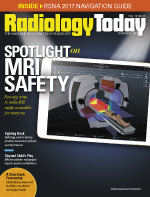 Imaging Informatics: Right Patient, Right Record — How a Multisite Imaging Practice Integrated Patient and Imaging Records
Imaging Informatics: Right Patient, Right Record — How a Multisite Imaging Practice Integrated Patient and Imaging Records
By Dave Yeager
Radiology Today
Vol. 18 No. 11 P. 8
Reconciling patient records with medical imaging is a challenge for today's imaging practices. Minor inconsistencies in patient records, such as the use of a middle name or initial, a change of address, or an incorrect birthdate, can result in multiple records for the same patient. Duplicate records can be problematic for any practice, but when they're spread across multiple practices and hospital systems, it becomes very easy to miss critical information about a patient's health.
This state of affairs is what Southwest Diagnostic Imaging (SDI) was experiencing when they decided to change the way they match patient records. SDI employs 130 radiologists and interprets approximately 2.5 million imaging studies each year. With 36 outpatient imaging centers spread over 980 square miles and professional services agreements with several hospitals, the volume of duplicate patient records was becoming a significant workflow issue.
"When we adjust all of these patient records from all of these different hospitals, the ability to be aware of the patient's history at those various facilities is very important, in terms of getting the relevant medical records—and billing records, for that matter—in front of the people who need to use them," says Brian Frohna, MD, chief technology officer at SDI. "From the radiologist's point of view, being aware that the patient had a prior chest X-ray two weeks ago in the hospital, when the patient presents today for a chest X-ray, is very valuable, especially when the history is something like, 'Follow up pneumonia' or 'Follow up congestive heart failure.'"
Growing Problem
Frohna says SDI's radiologists were writing 10 to 20 addendums a day for patient information that was discovered after an imaging study had been interpreted. In addition to the frustration associated with workflow interruptions, not having all of a patient's relevant priors and history can have an adverse effect on patient care. To more effectively match patient records and prior studies, SDI decided to implement NextGate's enterprise master patient index (EMPI).
"Before we went live on this, we had about 100,000 records that we thought, very likely, were duplicate medical records—in other words, patients that were in the system multiple times. For example, they either had a hyphenated last name that was entered without a hyphen or their address didn't match up or something like that. And all of that would have had to have been resolved manually," Frohna says. "And that's really when we realized that this was a big, important problem because it wasn't static at 100,000; it was 100,000 and growing. And as we continued to grow as a practice and get busier and busier, those duplicated patient records were increasing, not decreasing, and we were never going to catch up with that."
Right the First Time
Travis Haskins, CIO of SDI, says the EMPI uses patient identifiers, ZIP codes, shortened names, dates of birth, and other information fields to evaluate a patient record. It assigns each item a weight, which SDI sets based on how valuable they think the item is. The EMPI uses the weighted scores to set thresholds for merging records automatically, with human intervention, or not at all. The EMPI and SDI's systems are connected with Orion Health's Rhapsody software.
Haskins says the biggest challenge with the EMPI has been acclimating personnel to the new workflow; SDI had been using the same workflow since 2001. In addition to the EMPI, SDI also implemented a new RIS, which has caused some disruption. Despite the changes, he says the EMPI is helping to resolve patient identity discrepancies from disparate data systems.
"Patient data comes in collectively to the EMPI, it's resolved, matched up, and then sent out to our billing systems. Or when a patient calls and schedules an exam at one of our outpatient centers, the RIS system uses that EMPI to resolve their identity," Haskins says. "But the nice part is, if they've been seen in a hospital [emergency department], we're aware of them. We're aware of their exam that was done there, and we've matched them up at that point. We also use that information to identify records that need to be pulled from the hospital systems."
On the imaging side, relevant prior exams are prefetched and loaded into PACS before the patient has the imaging exam. Frohna estimates that SDI is now aware of about 99% of prior studies that patients have had at SDI's affiliated institutions. He says this knowledge has improved referrer satisfaction and patient care.
"The workflow, from the radiologists' point of view, hasn't changed dramatically, aside from the reduction in the number of addendums that we have to do. But it's always much nicer when you have confidence that the report that you're making today is going to be the only report that you're going to have to make on a given patient," Frohna says. "And I think it also increases the quality of your initial report, knowing that that's the one and final report that you have, and it really gets the relevant medical information to the patient's caregiver at the time of service—the first time."
In the future, SDI plans to expand the use of the EMPI. It was recently integrated with the online scheduling function of SDI's patient portal, which has grown increasingly popular over the past two years. Haskins says although it's impossible to eliminate human intervention 100%, SDI will continue to look for ways to use the EMPI.
"It's a culmination of about three years' worth of work. We still have more things to do," Haskins says. "We're not finished yet, by any means. I don't know if we'll ever be finished."
— Dave Yeager is the editor of Radiology Today.

